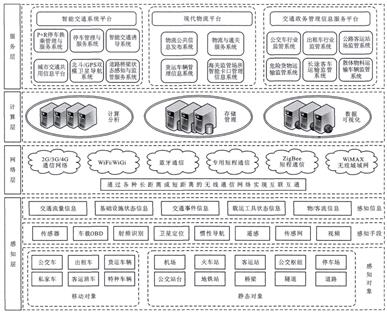| 泛在交通信息服务系统的概念、架构与关键技术 |
| |
| 引用本文: | 赵祥模, 惠飞, 史昕, 马峻岩, 杨澜. 泛在交通信息服务系统的概念、架构与关键技术[J]. 交通运输工程学报, 2014, 14(4): 105-115. |
| |
| 作者姓名: | 赵祥模 惠飞 史昕 马峻岩 杨澜 |
| |
| 作者单位: | 长安大学 信息工程学院 |
| |
| 基金项目: | 国家自然科学基金项目(51278058);交通运输部科技项目 |
| |
| 摘 要: | 
分析了现有交通信息服务系统存在的感知能力有限、服务方式单一和动态信息更新不及时的问题, 围绕当前交通工程和信息技术领域的研究发展趋势, 提出了一种泛在交通信息服务系统(U-TISS)的架构, 将先进的协同感知、泛在网络、云计算、大数据等技术综合运用于交通信息服务领域, 实现交通信息服务系统与交通物理系统的深度融合。U-TISS架构包括感知、网络、计算和服务4层次。感知层主要通过传感器、射频标签、识读器、摄像头、全球定位系统、车载智能终端设备等, 实现对人、车、路、环境的全面感知; 网络层是以ZigBee、蓝牙、DSRC等短程通信为主的末梢节点通信与以3G/4G或有线通信链路为主的承载网络通信, 通过车路短程通信和自组织网络、路侧与感知中心的承载网络实时采集和传输各种交通信息, 构建交通要素信息的精准获取与发布体系; 计算层利用云计算技术实现有效的交通富信息挖掘与提取, 提升交通信息服务质量; 服务层构建基于泛在网络和云计算的交通信息服务平台, 通过移动智能终端、车载终端、资讯广播、可变信号板等信息发布方式, 为交通参与者提供实时动态的交通信息服务和丰富全面的辅助决策支持, 实现交通信息服务的智能化与个性化。基于U-TISS架构, 分析了实现U-TISS的关键技术, 包括智能终端的普适感知与交互、车辆精确定姿与定位、交通信息路侧协同感知、车车/车路短程通信与组网、车载移动互联、交通信息云管理、交通大数据分析与挖掘、信息安全与隐私保护。分析结果表明: U-TISS具有泛在感知、开放互联、实时传输、深度挖掘与优质服务的特点, 能够从安全性、高效性、便捷性和环保性4方面改进与提升现有交通信息服务系统的服务水平。在安全性方面, 基于DSRC的车车/车路通信与组网技术使驾驶人可以获取超越视距、超车载感知能力范围与多时空尺度的交通信息, 增强车车/车路间的协同能力; 在高效性方面, 借助泛在感知的海量路网运行信息和云计算平台提供的大数据分析技术, 通过精细化的管理实现交通系统的高效运行; 在便捷性方面, 通过智能终端能够为公众出行路线、方式和出发时间的个性化定制提供支持; 在环保性方面, 通过对车辆控制系统提供更多的行车环境信息实现车辆控制的优化, 通过大数据或社交网络提高驾驶人对环保驾驶的认知, 实现绿色出行。U-TISS关键技术的深入研究、推广与应用, 及相关行业标准与规范的出台, 将引起交通信息服务类应用商业模式的创新与变革, 最终实现协作式智慧交通。

|
| 关 键 词: | 智能交通系统 交通信息服务 泛在网络 体系架构 关键技术 |
| 收稿时间: | 2014-04-21 |
| 本文献已被 万方数据 等数据库收录! |
| 点击此处可从《交通运输工程学报》浏览原始摘要信息 |
|
点击此处可从《交通运输工程学报》下载全文 |
|


